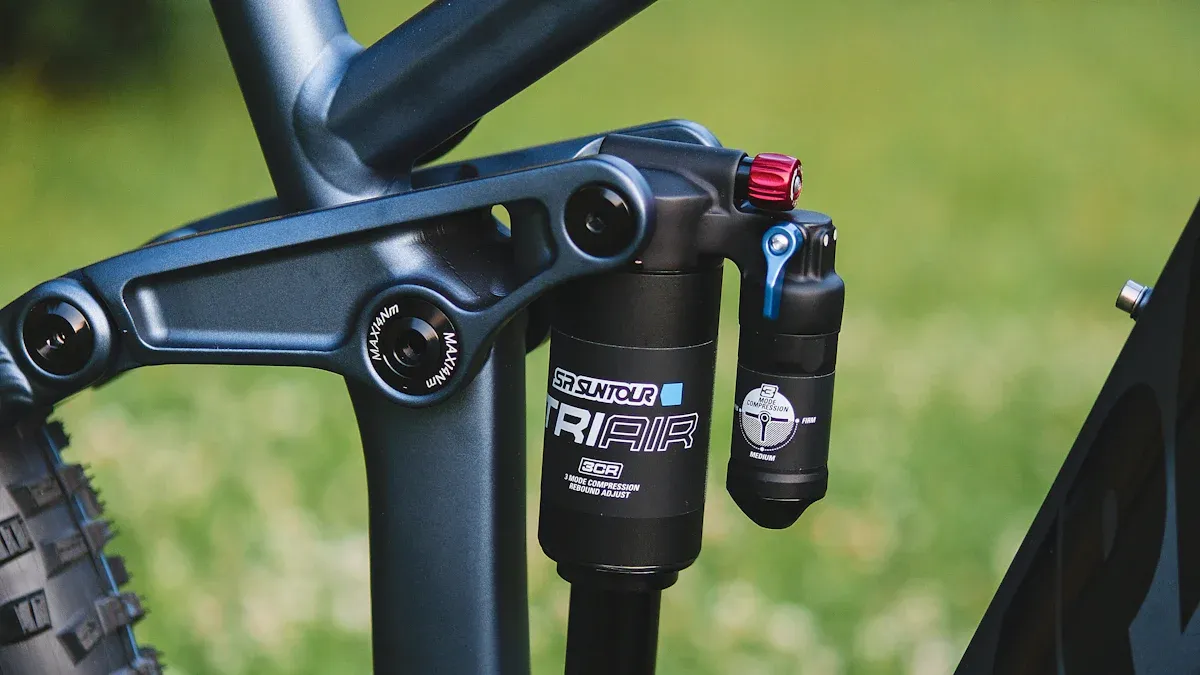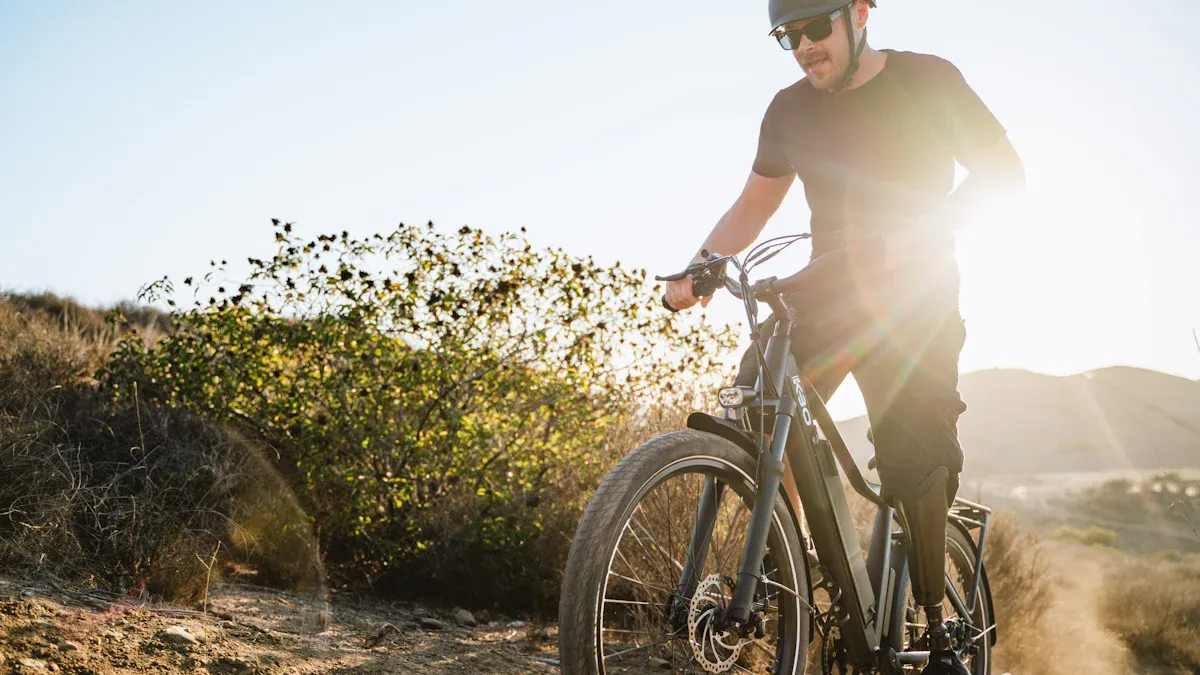
Choosing the right rigid bike frame is very important for your off-road trips. A strong frame can really help with how well you ride and how comfortable you feel on rough trails. Rigid mountain bikes are getting more popular with fans who like their simple design and strong build. In 2025, you should think about things like frame material, shape, and tire fit to find the best match for your riding style.
Key Takeaways
Picking the right frame material is very important. Steel gives comfort and strength. Aluminum is light and stiff. Think about your riding style when you choose.
Bike shape changes how you ride. A longer reach helps with stability at high speeds. A shorter reach helps with tight turns. Choose a shape that fits your needs.
Tire compatibility makes your bike work better. Wider tires give better grip on rough ground. Choose tires based on the off-road conditions you will face.
Top bikes like the Surly KM and Farley 5 have special features for different riding styles. Look up each bike’s details to find the best one for you.
User reviews are very helpful. They show real-life performance. Reviews can help you see the good and bad sides of each bike.
Key Features of Rigid Bike Frames

When you pick a rigid bike frame for off-road fun, knowing the key features helps a lot. Let’s look at the three most important parts: frame material, geometry, and tire compatibility.
Frame Material
The material of your rigid bike frame is very important for how it performs and lasts. Here are the most common materials used in rigid bike frames:
Steel
Aluminum
Titanium
Carbon fiber
Chromoly
Each material has its own good and bad points:
Steel Frame: Strong against impacts and comfy but heavier and can rust.
Aluminum Alloy Frame: Light and stiff, good for speed, but less comfy and weaker against impacts.
Carbon Fiber Frame: Very light and resists wear well, but not great against impacts and costs a lot.
Titanium Alloy Frame: Light and strong with great comfort, but expensive and not as stiff.
Choosing the right material can change how your bike rides on rough ground. For example, if you want a bike that soaks up bumps, steel might be best. But if you want something lighter for climbing, aluminum or carbon fiber could work better.
Geometry
The geometry of a rigid mountain bike greatly affects how it rides on different surfaces. Here’s a quick look at some key geometry details and why they matter:
Geometry Specification | Importance | Impact |
|---|---|---|
Longer Reach | Gives a more aggressive riding position | Makes it stable at high speeds but may make tight turns harder. |
Shorter Reach | Provides a more upright riding position | Helps with tight turns but may make high speeds less stable. |
Head Angle | Affects how quickly it steers and its stability | Steeper angles steer faster; slacker angles are more stable. |
Effective Top Tube Length | Influences how far you reach and frame size | Affects how you sit and feel for better control and efficiency. |
Wheelbase | Changes stability and how easy it is to turn | Longer wheelbases are stable; shorter ones are better for quick turns. |
The right geometry can make you more comfy and in control on off-road paths. For instance, a higher bottom bracket helps you get over obstacles easier, while a longer wheelbase makes you more stable on bumpy ground.
Tire Compatibility
Tire compatibility is another key feature to think about. The right tires can really boost your bike’s grip and performance on different surfaces. Here’s a look at common tire widths and what they do:
Tire Width | Description |
|---|---|
2.1 – 2.3” | Light and fast – great for XC racing/riding and smooth singletrack |
2.4 – 2.6” | Trail tires have great grip on loose and tricky terrain but still roll fast |
2.8 – 3.0” | Also called ‘plus’ or ‘mid-fat’ – great for traction and comfort but slower |
3.5 – 5.0” | Fat bike tires for maximum float and grip, often used in snow |
Choosing the right tires is very important for off-roading. Off-road tires are made for rough ground, giving better grip and handling. Aggressive tread patterns help you move through mud and dirt, while wider contact patches make you more stable on soft ground.
Top Rigid Mountain Bikes for 2025

Choosing the best rigid mountain bikes for 2025 gives you great choices. Each bike has special features for different riding styles and terrains. Let’s look at some of the top models you should think about.
Surly KM
The Surly Karate Monkey (KM) is a flexible bike. It works well on tough trails and for bikepacking. Here are some of its best features:
29+ Tire Compatibility: This bike fits larger tires. This helps with grip and shock absorption on rough ground.
Trail-Optimized Geometry: The geometry balances quickness and stability. It’s great for trail rides.
Grounded Ride Feel: You’ll have a smooth ride, even on hard trails.
Durable Construction: Made from 100% Surly Chromoly Steel, this bike is tough for all your trail rides.
Build Kit: The mix of stability and quickness, plus big tires, gives great grip and climbing power.
The Surly KM is not just about how it rides; it’s also a good deal. You can pick between rigid or suspension builds. The suspension option costs an extra $650. With a strong Chromoly steel frame and a SRAM Eagle 1×12 groupset, this bike is great for climbing, especially when loaded for bikepacking.
Surly Krampus
Next is the Surly Krampus, a bike known for its unique design and performance. Here’s what makes it special:
Component | Specification |
|---|---|
Frame | 100% Surly Chromoly Steel, Natch tubing, double-butted main triangle |
Fork | 100% Surly Chromoly Steel, Natch tubing, double-butted main triangle |
Rear Derailleur | Shimano M6100 Deore SGS |
Crank | Shimano MT511, 30T |
Cassette | SunRace CSMZ800, 11-51t, 12-spd |
Tires | Surly Dirt Wizard 29 x 3″, Tubeless Ready |
Wheel Size | 29 x 3″ |
Head Tube Angle | 69° |
BB Drop | 65 mm |
The Krampus is made for 29+ tires, giving better grip and shock absorption. Its geometry has a steady 69° head tube angle. This balances quickness and stability, making it good for many conditions. Riders love its fun handling and solid performance on rough trails.
Surly ICT
The Surly Ice Cream Truck (ICT) is another great choice for off-road fans. Here’s what you can expect:
Specification | Details |
|---|---|
Frame Material | |
Tire Size | 26 x 4.8 inches |
Weight | About 30 lbs |
Gearing | 1x or 2x drivetrain options |
Brakes | Hydraulic disc brakes |
Color Options | Many colors available |
Price Range | $1,500 – $2,000 |
The ICT is great for handling and grip on different off-road conditions. It has wide tires for good traction and different gearing options for various terrains. Riders enjoy its fun and aggressive handling, making it good for many trails.
Surly Wednesday
The Surly Wednesday is made for flexibility, perfect for off-road touring and trail riding. Here are its main features:
Feature | Description |
|---|---|
Versatility | Good for both off-road touring and trail riding. |
Tire Clearance | 26 x 4.6″ tire clearance for fat biking. |
Modern Standards | Has stealth dropper post routing, 44mm headtube, and thru-axles. |
Braze-ons | Full set for racks, mounts, and fenders for more use. |
Brake Configuration | Disc brakes with 51mm I.S. for both front and rear. |
The Wednesday’s geometry and ability to fit larger tires make it great for off-road riding. You can handle many terrains, from soft sand to snowy trails, with ease.
Farley 5
Finally, the Farley 5 is a great choice for year-round riding. Here’s what makes it special:
Versatility: The Farley 5 works on many terrains, like snow, sand, and rough trails.
Carbon Fork: It has a carbon fork with many mounts for gear, making it useful for adventure biking.
Tire Size: It comes with 4.5-inch tires for great flotation and grip.
Progressive Trail Geometry: This design helps with stability and confidence while riding.
Internally Routed Dropper Post: Makes it easy to adjust during descents.
Seat Tube Angle | Head Angle | Wheelbase | |
|---|---|---|---|
15.5″ (S) | 72.5° | 68.5° | 109.7 cm |
17.5″ (M) | 72.5° | 68.5° | 113.1 cm |
18.5″ (L) | 72.5° | 68.5° | 116.6 cm |
19.5″ (XL) | 72.5° | 68.5° | 120.7 cm |
The Farley 5 is a great value fat bike, perfect for year-round riding. Users like its light frame and drivetrain, often noting its versatility in winter conditions.
User Reviews of Mountain Bikes
Surly KM Review Summary
Users love how the Surly KM performs on tough trails. They like its stability and comfort, especially on bumpy surfaces. The Knard tires do a great job of soaking up vibrations. This gives you a smooth ride over rocky paths. Many riders think it works well on hard terrains, making it a top choice for off-road fans.
Surly Krampus Review Summary
The Surly Krampus gets high ratings for its ability to handle different terrains. Here are some common likes and dislikes:
Strengths:
Smooth ride with 29+ tire fit.
Very easy to steer and stable on tricky ground.
Weaknesses:
Some users say the bike is heavy.
The 1X10 gears can make steep climbs harder.
Riders enjoy how fun and quick the Krampus feels. Its design, with a higher bottom bracket and slacker head tube angle, helps it perform well on steep trails. Overall, it’s seen as a fun and confidence-boosting bike for off-road rides.
Farley 5 Review Summary
The Farley 5 impresses users with its comfort and strength. Here’s a quick look at what users say:
User Experience | Description |
|---|---|
Comfort Level | The setup is pretty comfy, but the seat could be better. |
Climbing Comfort | The Farley climbs well with a comfy sitting position and good grip. |
Rider Position | Riders like how comfortable they feel while climbing, thanks to its reach. |
Many users like the Farley 5’s versatility, making it good for different terrains, like snow and sand. It’s a great choice for riding all year, and its light frame makes it even better.
Rigid bike frames are great for off-road riding. They give you good traction and comfort, especially with plus-sized tires. You can use lower tire pressures, which helps grip on different terrains. Also, Chromoly frames are very strong, making them great for bikepacking trips.
In this post, we talked about some top models like the Surly KM and Farley 5. Each bike has special features for different riding styles. Think about what you need when picking a bike. Whether you want comfort, stability, or versatility, there is a rigid bike frame for you!
FAQ
What are the benefits of a rigid bike frame for off-road riding?
Rigid bike frames give you better control and stability on bumpy trails. They help you feel every bump and turn on the path. They are also lighter and simpler, which makes them easier to take care of.
How do I choose the right frame material?
Think about how you ride and what you like. Steel is comfy and strong, while aluminum is light and stiff. Titanium is strong and comfy but costs more. Carbon fiber is light but can break easily. Each material has good and bad sides.
Are rigid bike frames suitable for all types of terrain?
Yes, rigid bike frames can work on many surfaces, like rocky trails, dirt paths, and even snow. But the right tires and frame shape are very important for how well it performs. Make sure your bike fits the type of riding you want to do.
How important are user reviews when selecting a bike?
User reviews give real information about how a bike works and lasts. They can show strengths and weaknesses that numbers alone might miss. Always read different reviews to get a full picture before you buy.
Can I use a rigid bike for bikepacking?
Yes! Rigid bikes are great for bikepacking because they are strong and can carry loads. Look for bikes with enough spots to attach racks and bags. A comfy design will also help you ride longer distances.
See Also
New Developments in Electric Bike Frames for 2025
The Advantages of Carbon Frames for Cyclists in 2025
The Importance of Steel Frames for Road Bikes in 2025
Comparing Enduro Bike Frame Materials for Durability and Strength
Guidelines for Selecting the Best Carbon Mountain Bike Frame
